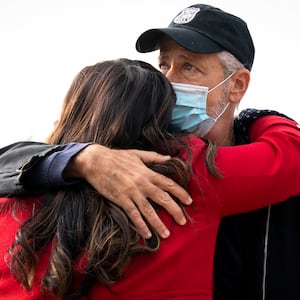David Parker, whose 12-year military career included deployments as a Marine to Iraq and Afghanistan, was getting out of his car last July at the Veterans Health Administration outpatient clinic in Fort Collins, Colorado, to seek treatment for his injured back when it suddenly gave out.

His body below his waist went numb. His face hit the pavement, and he lost control of his bowels.
As a former military service member, he is one of more than nine million Americans who get medical care from the VA system, the federal government’s sprawling array of 170 hospitals and more than 1,000 clinics. Parker, who is 34, was transported to the hospital in an ambulance and was given a week’s worth of the opiate codeine as part of his treatment.
He regretted what happened next.
“You were supposed to take, like, two a day, max, and I was taking—I think, like, by the fifth day, I was taking four. Four or five a day,” he told The Daily Beast. “I was popping them like Skittles.”
Parker worried about becoming addicted. That’s why, the next month, after a cross-country move—when he went to an East Coast VA hospital for a pancreatic cancer screening and complained about his aching back—he was adamant that he not be given opiates. Staff gave him a pill that they said was ibuprofen, he claimed. In 20 minutes, his back felt great.

“Whatever that ibuprofen was, I need to get that prescribed,” Parker said he told the doctor.
“Well, it’s codeine,” the doctor replied, according to Parker.
He was stunned. He did not want opiates, for fear of addiction, and he said he had informed the nurse of that very concern. Yet he said he was given them anyway.
Although officials at the VA could not speak to Parker’s individual case due to privacy concerns, a spokesperson did tell The Daily Beast that the facility in question “follows standard guidelines for the safe prescribing of opioids and routinely monitors facility and provider level prescribing patterns.” They added that the facility was well below national targets for prescribing opioids.
But among former military members, Parker’s experience is far from unique, interviews and a review of recent audits of VA care show. And even as the coronavirus pandemic continues to dominate the public-health conversation in America, veterans and their advocates say the agency needs to do more to rein in opioids before it’s too late.
The Veterans Administration has come under withering criticism in recent years for contributing to the nation’s opioid epidemic. A decade ago, the VA prescribed opioids to one out of every four veterans in its care, according to government statistics. Due to injuries endured in combat, veterans are more likely than civilians to be dealing with serious pain. But the staggering number of prescriptions caused grave concerns.
Critics included the American Legion, one of the nation’s largest veterans’ groups, which in 2015 reported, “Overuse of opiate prescriptions clearly creates problems for veterans within the VA health-care system.”
Floyd Meshad, a Vietnam War veteran who runs the nonprofit National Veterans Foundation based in Los Angeles, California, opposes long-term opioid therapy for veterans in general. “If you get opioids and you stay on or get hooked, you don’t know if you’re better or not. You don’t feel anything,” he told The Daily Beast.
Meshad asserted the VA has a history of not examining other treatment options: “The VA’s primary treatment is chemical treatment,” he said.
It should be noted that the VA has succeeded in reducing opioid use among veterans as the opioid crisis gained national consciousness. In the past eight years, the agency has cut opioid prescriptions by 64 percent, from more than 679,000 in 2012 to 247,000 in 2020. It reduced the number of patients receiving opioids and benzodiazepines together, a combination that has often led to death, by 87 percent in the same timeframe. Officials credit the expanded use of alternative therapies and treatments, like acupuncture and cognitive behavioral therapy; the VA has also benefited from “aggressively emphasizing the safe and responsible use of prescription opioids,” according to a report issued by the VA’s Office of Public and Intergovernmental Affairs.
In 2013, the VA launched its Opioid Safety Initiative, and in 2018, according to Dr. Friedhelm Sandbrink, the Acting National Program Director for Pain Management, it hired pharmacists trained to educate doctors who may be overprescribing opioids on best practices. It also instituted revised procedures that are supposed to reduce the chance for addiction. The procedures include doing a behavioral assessment of veterans to check for a family or personal history of addiction before prescribing opioids, conducting urinalysis tests for illicit use, obtaining documented informed consent from veterans in which they are warned that opioid use could kill them, and following up with patients prescribed opioids for long amounts of time.
The changes reflected a shift in the VA’s thinking around opioids, according to Dr. Sandbrink. “I think we realized even more that the risks of opioid medications probably outweigh the benefits for many patients,” he told The Daily Beast.
But Inspector General reports over the past year show VA facilities nationwide are still putting scores of veterans on opioids without first following their own safeguards.
According to a Daily Beast review of dozens of audits, VA staffers are failing to assess veteran patients for risks like a family or personal history of addiction prior to prescribing opioids. They aren’t consistently obtaining documented informed consent from veterans in which they are warned that their opioid use could kill them. They often aren’t obtaining urinalysis tests to check for illicit use, or conducting follow-ups with patients on opioids for long terms. All of these procedures were outlined in the VA’s own updated clinical practical guidelines in 2017, and some also appeared in internal directives issued in 2009 and 2020.
VA officials painted a different picture of the status quo.
“The VA has been recognized by many as a leader in the pain management field for the responsible use of opioids as well as in the treatment of Opioid Use Disorder, and the department is sharing its knowledge and experience with federal and local governments and across the nation’s health-care networks,” a spokesperson told The Daily Beast in response to the audit findings.
Yet the audits indicate that the VA is still falling short. Most of the reports, published in the second half of 2020 and the beginning of 2021, documented dramatic shortcomings in checking veterans for whether they were at risk to become addicted to opioids. In the 28 audits released with the new procedures, only five medical centers—including Tomah, Wisconsin, Dayton, Ohio, and Saginaw, Michigan—were found to have assessed all of their patients for risks like a history of addiction prior to prescribing opioids. Only three consistently obtained documented informed consent from veterans to confirm they knew that opioid therapy can carry deadly risks. And only eight audits found VA facilities that conducted routine follow-ups with all of their patients on opioids.
A spokesman for the VA Inspector General declined to comment on the patterns in the audits or on individual cases. The VA’s Office of Public Affairs also said it would not comment on specific cases, citing patient confidentiality concerns. Sandbrink argued that the VA’s national levels for obtaining documented informed consent and testing veterans’ urine are much higher than the levels found in the audits, though the study he referred to was conducted exclusively by employees of the VA.
The VA facilities in Montgomery and Tuskegee, Alabama, performed as poorly as anywhere in the country, according to the audits. Practitioners at two clinics and a hospital failed to screen over two-thirds of veterans for a family or personal history of substance abuse. Only 45 percent were checked for addiction behaviors that suggest out-of-control drug use. And 79 percent were not given a form that confirms they understand that their opioid prescriptions pose deadly risks.
“The [Office of the Inspector General] observed significant concerns with medication management of long-term opioid therapy,” the inspectors reported.
Officials cited a shortage of providers and recruiting challenges due to their rural location as reasons they did not comply with behavioral assessments. They said they were not aware that requirements were in place to obtain veterans’ documented informed consent acknowledging that opioid therapy could kill them.
At a Kansas City, Missouri, VA hospital, the Inspector General reported, staff failed to check 64 percent of patients for histories of drug abuse.
”Deficiencies with aberrant behavior risk assessment, urine drug testing, informed consent, patient follow-up, and quality measure oversight… may have resulted in providers prescribing opioids for patients at high risk for misuse,” auditors wrote.
Hospital officials told auditors, according to the report, that “because [opioid] risk assessments were often documented by other clinicians during varied episodes of care, providers believed requirements were met.” Nevertheless, the Inspector General recommended that the hospital revise its procedures and ensure patients are checked for increased chances of addiction.
Many facilities were found to have failed to check the urine of a significant number of patients on long-term opioid therapy for illicit use. Auditors found that Madison, Wisconsin’s VA hospital failed to test 55 percent of patients. Officials told auditors that they were unaware of the requirement. This was not unusual: only seven of the 28 audits found hospitals consistently obtained urine drug tests, and many cited a lack of awareness or inattention to detail as the reasons for their failings.
A few VA facilities, like in Chicago, Illinois, and Birmingham, Alabama, failed to document justifications for prescribing anti-anxiety benzodiazepines at the same time as opioids—a combination that exponentially increases the chances of fatal overdose. Officials in Chicago told auditors that they trusted that clinicians who prescribed opioids reviewed the notes of clinicians who had prescribed the same veterans benzodiazepines, but acknowledged there was no evidence they had discussed the risks and benefits with patients, or provided justification for it. Birmingham officials stated that clinicians did not pay attention to the requirements.
Other VA medical centers around the country responded to the auditors with different reasons for their failures. Officials at the Madison and North Chicago facilities claimed they were unaware that monitoring requirements were in place to check for things like a history of substance abuse and adherence to long-term opioid therapy through urine drug testing. An official at the Danville, Illinois, center said that all of their long-term opioid therapy oversight stopped in general because medical staff had higher priorities. An official in Wichita, Kansas, stated that filling out separate progress notes was tedious, resulting in providers not consistently obtaining documented informed consent from veterans in which they are warned that their opioid use could kill them.
The Inspector General does not review every hospital each year, and has only begun publishing checks on these opioid prescription protocols in the past 11 months. But they offer a rare snapshot into whether VA medical staff have been examining patients for their risk of addiction.
Despite the extensive failures found by inspectors, the agency may be shifting resources. As of last fall, it was moving on from questioning opioid therapy to another major concern: medication prescribed to treat COVID, according to a VA official. The public may never know how other VA facilities perform on checking for a history of addiction or obtaining documented informed consent from veterans about the fatal risks of opioid treatment.
After Corey Troyer’s dad died of an opioid overdose in June 2011, Troyer went to his father’s house and found four different bottles of opioids. He checked the dates and discovered that they were all prescribed within three months of each other by the VA near his home in Tacoma, Washington, he said. Troyer’s dad John had a history of opioid addiction, for which he was in rehab from 2006 to 2008, he added.
Troyer is unsure whether the VA asked about his father’s history of addiction prior to prescribing him opioids, but he believes that regardless, the institution is to blame for his death.
“The VA just likes to throw medication at people to try to make them better instead of finding the root cause of what is actually wrong,” he said. The VA Puget Sound Healthcare System did not respond to requests for comment for this story.
Merrie Brundage has a similar beef. Her late husband, Paul, who served in Vietnam, turned to the Augusta, Georgia, VA in 2009 to treat his neck pain, back pain, and PTSD. He was prescribed the opioids hydrocodone and tramadol, as well as muscle relaxants and antidepressants, she recalled. Brundage’s husband had a history of substance abuse, and progress notes issued by the VA—and reviewed by The Daily Beast—reflect that they knew he had one and that “his drug of choice [was] Opiates.” That didn’t prevent doctors from dispensing them to him anyway, according to Brundage.
Brundage’s husband started abusing his medications, especially his opiates, and getting extra pills from coworkers, which Brundage said she told the VA many times. The doctors still didn’t change anything about his regimen, she claims.
After gashing his head one morning in the fall of 2011 after taking an excessive amount of his antidepressant and his daughter’s muscle relaxants, Paul Brundage walked outside, fell into a retention pond, and drowned. The death certificate prepared by the Georgia Department of Human Resources said that the combination of pills was deadly.
“Everything went south when he started going to the VA,” Brundage said. Even though her husband died in part from taking pills he was not prescribed, she still blames the agency for reawakening and enabling his addictive behavior. “As far as I’m concerned, they killed him.”
The Augusta VA declined to comment on Brundage’s story, citing patient privacy concerns.
Alex S. Bennett, a principal investigator at New York University’s School of Global Health who is conducting a four-year study on opioid use and misuse in the veteran community, said that making an array of resources and services accessible is key to reducing the risk of overdoses.
Because many veterans have been injured in the line of duty and experience chronic, long-term pain, they are more susceptible to suffer from opioid dependence and overdose, he said, adding that he believes the VA has made improvements in curbing addiction.
Veterans facing difficulties adjusting back to civilian life can encounter homelessness, unemployment, and post-traumatic stress disorder—all factors associated with a heightened risk of opioid overdose.
“Oftentimes we look at the drug as the root of evil or good… and really it’s everything else. It’s the housing, it’s the mental health, it’s the physical health. So I think rather than focusing on the drugs as much, we need to focus on the whole person, the whole veteran,” Bennett said.
Getting veterans off opioids after they’ve been prescribed them is difficult and risky. In a study of over a million veterans who received opioid prescriptions from the VA in fiscal years 2013 and 2014, veterans were found to die in greater numbers from overdose or suicide after stopping treatment, with heightened risk the longer patients were treated before stopping.
Meanwhile, the VA Office of the Inspector General continues to publish audits that examine VA oversight of opioid treatment. The most recent report was published on May 27. And veterans are continuing to speak out, enraged at what they see as an institutional failure.
Todd Doyle was in the Air Force from 1989 to 2013. He was prescribed sleeping pills, muscle relaxants, antidepressants, antihistamines, opioids, and opiates by the Reno, Nevada, VA, after his service to treat post-traumatic stress disorder, as well as disk degeneration in his back, he said.
Doyle became concerned about the combination of medications he was on, noting he was on so many different ones that he stored them in a tote bag. He finally believed he needed to see a non-VA doctor when, while under the influence of the cocktail of medications prescribed to him, he passed out in the middle of the aisle of a Safeway drug store, he recalled. His wife and son had to carry him to the car.
A spokesperson for the Reno VA declined to comment, as did Doyle’s doctor from the VA, both citing patient confidentiality.
Doyle has since switched to a civilian doctor and weaned himself off opioids, but remains stunned at the hole he found himself in.
“I mean, literally, I felt like they were just gonna prescribe stuff until I was dead,” he said.



